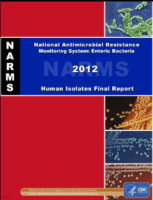As Ongoing Outbreaks Make Headlines, CDC Trumpets Antibiotic Resistance Data

One week after its initial release of data from 2012 showing that antibiotic resistance in foodborne pathogens is an ongoing public health threat, the U.S. Centers for Disease Control and Prevention (CDC) on July 10 issued a "Special Edition" newsletter promoting its report and touting what federal agencies are doing to improve food safety.
Entitled "Antibiotic Resistance in Foodborne Germs," the newsletter is geared to a broad audience that includes the general public. The newsletter both summarizes and links to the report by CDC’s National Antimicrobial Resistance Monitoring System (NARMS) study on which FSM reported last week. It also provides links to information on foodborne illness outbreaks that CDC is tracking (Salmonella in several brands of chia seed-based food products and Salmonella Heidelberg in Foster Farms chicken products), and outlines what various government agencies are doing to combat antibiotic resistance.
[Editor's Note: In related news, a study published July 10 in The Lancet Infectious Diseases found that between 2000 and 2010, global consumption of antibiotic drugs increased by 36%. Disturbingly, the study also reported that consumption of two "last-resort" classes of antibiotics had increased significantly — use of carbapenems was up 45% and use of polymixins rose 13%,].
Key points from the CDC newsletter included:
- Each year, antibiotic-resistant infections from foodborne germs cause an estimated 440,000 illnesses in the United States.
- The report from CDC NARMS compares resistance levels in human samples in 2012 to a baseline period of 2003-2007.
- The report introduces a new method for interpreting Campylobacter data and includes links to online interactive graphs where users can choose an organism and an antibiotic and see the “bug-drug” trends from year-to-year in NARMS.
Regarding how various U.S. agencies are combatting antibiotic resistance, the newsletter highlighted:
- The CDC's 2013 Threats Report, which connects antibiotic resistance to foodborne and other enteric (intestinal) pathogens in animals, food, and humans.
- The Food and Drug Administration's (FDA) animation of antimicrobial resistance.
- The Interagency Task Force on Antimicrobial Resistance (ITFAR) and its public health action plan to combat antibiotic resistance.
- The National Antimicrobial Resistance Monitoring System for Enteric Bacteria (NARMS) and its 2012 NARMS Annual Report.
- The Pew Charitable Trusts, which aims to preserve the effectiveness of antibiotics by phasing out the overuse and misuse of the drugs in food animal production, in part by distributing a fact sheet entitled "10 Facts About Antibiotics, Resistance, and Food Animal Production."
- The U.S. Department of Agriculture (USDA), which features the following on its website: Questions and Answers: Judicious Use of Antimicrobials in Food-Producing Animals.
The CDC's newsletter calls antibiotic resistance "public health’s ticking time bomb," noting that it annually causes more than two million illnesses and 23,000 deaths nationwide. As noted above, antibiotic resistance in foodborne pathogens is responsible for about 440,000 of those illnesses.
The FY 2015 President’s Budget requests funding for CDC to improve early detection and tracking of multidrug resistant Salmonella and other urgent antibiotic resistance threats. The proposed initiative would increase CDC’s ability to test drug-resistant Salmonella by 20 times. With a $30 million annual funding level over five years, CDC estimates that it could achieve a 25% reduction in multidrug resistant Salmonella infections, as well as significant reductions in other resistant infections.
The CDC reported that its National Center for Environmental Health has developed two new food safety tools, an e-learning course on Environmental Assessment of Foodborne Illness Outbreaks and the National Voluntary Environmental Assessment Information System (NVEAIS). The e-learning course prepares individuals for team investigations of foodborne illness outbreaks in restaurants and other food service areas. It is offered free of charge and provides continuing education units (CEUs). The NVEAIS is a surveillance system for jurisdictions that inspect and regulate restaurants and other food areas, such as banquet facilities, schools, and other institutions. It captures underlying environmental assessment data that describes what happened and how events most likely led to a foodborne illness outbreak.
Looking for a reprint of this article?
From high-res PDFs to custom plaques, order your copy today!





